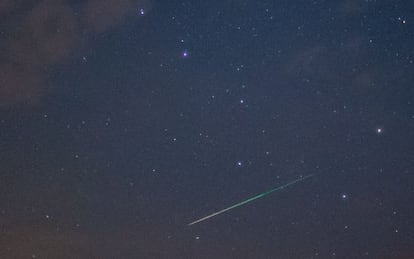The Perseids 2015: summer meteor shower at its peak this week
There’s still time to catch a glimpse of the shooting star phenomenon over the coming days

If you missed out last night, when the phenomenon was due to reach its peak, there’s still time to catch a glimpse of the annual Perseid meteor shower over the next few days.
Every year between the middle of June and the middle of August, the Earth passes through a cloud of cosmic dust, filling the night sky with shooting stars. The body responsible for this summer spectacular is the Swift-Tuttle comet, which visits our planet every 133 years, leaving behind a trail of celestial debris in the middle of our orbit path. When the Earth passes through it, traces of the comet enter our atmosphere at high speeds of around 59 kilometers per second.
Entry heats the meteoroids up to 10,000ºC, causing them to shine briefly in the night sky like stars
Entry heats the meteoroids up to 10,000ºC, causing them to shine briefly in the night sky as though they were stars. Because the event falls around the time of Saint Lawrence’s Day on August 10, the shooting stars have been dubbed “the tears of Saint Lawrence” in honor of the saint who was roasted alive by the Romans in 258 AD. Seemingly originating in the constellation of Perseus they have also been named the Perseids.
The best moment to see them is at a midpoint between sunset and sunrise – from around 1am to 3am. According to the Canaries Astrophysics Institute (IAC), it will be possible to see up to 120 Perseids, approximately two a minute, at peak moments and the good news is that the new moon on August 14 will not hinder visibility.
That said the phenomenon is best seen in areas away from the artificial light of towns and conurbations and by watching the largest patch of night sky possible, in order to give yourself the chance of glimpsing as many shooting stars as you can.
The phenomenon is best seen in areas away from the artificial light of towns and conurbations
Miquel Serra-Ricart of the IAC says that while the Perseids are not “the most spectacular shower this year,” some individual shooting stars can be very impressive because of the high speeds at which they enter the atmosphere. He points out that the Perseids travel much faster than the Geminid meteor shower, which takes place in December, and only reach speeds of around 35 kilometers per second.
And don’t worry if you can’t get a glimpse of the Perseids this time round. There are more than 100 meteor showers over the course of the year, most of them taking place between mid-October and the end of December.
Tu suscripción se está usando en otro dispositivo
¿Quieres añadir otro usuario a tu suscripción?
Si continúas leyendo en este dispositivo, no se podrá leer en el otro.
FlechaTu suscripción se está usando en otro dispositivo y solo puedes acceder a EL PAÍS desde un dispositivo a la vez.
Si quieres compartir tu cuenta, cambia tu suscripción a la modalidad Premium, así podrás añadir otro usuario. Cada uno accederá con su propia cuenta de email, lo que os permitirá personalizar vuestra experiencia en EL PAÍS.
¿Tienes una suscripción de empresa? Accede aquí para contratar más cuentas.
En el caso de no saber quién está usando tu cuenta, te recomendamos cambiar tu contraseña aquí.
Si decides continuar compartiendo tu cuenta, este mensaje se mostrará en tu dispositivo y en el de la otra persona que está usando tu cuenta de forma indefinida, afectando a tu experiencia de lectura. Puedes consultar aquí los términos y condiciones de la suscripción digital.









































